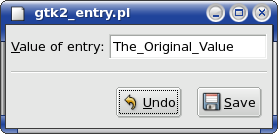Chapter 9. Gtk2::Dialog and Gtk2::Entry
Objective
When using a Gtk2::Entry widget, you usually call up a value already in existence, and assigns it to the Gtk2::Entry. This value may get changed by the user. (a value in a config file or a field in a database). Gtk2::Entrys may show up in a Gtk2::Dialog box.
A Gtk2::Dialog box is a subclass of Gtk2::Window. A brief description: " Dialog boxes are a convenient way to prompt the user for a small amount of input, eg. to display a message, ask a question, or anything else that does not require extensive effort on the user's part. "
Then the man page gives us more info: "Gtk+ treats a dialog as a window split vertically. The top section is a Gtk2::VBox, and is where widgets such as a Gtk2::Label or a Gtk2::Entry should be packed. The bottom area is known as the "action_area". This is generally used for packing buttons into the dialog which may perform functions such as cancel, ok, or apply. The two areas are separated by a Gtk2::HSeparator."
This lesson will go through a simple program that uses a Gtk2::Dialog with one entry widget, an undo, and a save button. The program will also implement error checking, to prevent bogus entries.
Table 9-1. Gtk2 object classes used
Gtk2 Class Name |
|---|
Gtk2::Window |
Gtk2::VBox |
Gtk2::HBox |
Gtk2::Button |
Gtk2::Entry |
Gtk2::Dialog |
Gtk2::MessageDialog |
Method of implementation
We need to implement the following steps in the program:
Create a
Gtk2::DialogcontainingSaveandUndobuttons.Add an
Gtk2::Entrywidget to theGtk2::DialogRead the current value and assign it to the
Gtk2::Entrywidget.Check for changes in the value of the
Gtk2::Entrywidget. If there were any changes, and it is not bogus values, activate theSaveandUndobuttons.When
Saveis clicked, give the user an indication, and exit the application.When the
Undobutton is clicked, re-read the original value, and set theGtk2::Entrywidget accordingly, also gray the buttons out again.
The screenshot
9.1. The Code
The program can be found here: 'Entry Demo'
1 #! /usr/bin/perl 2 3 use strict; 4 use Glib qw/TRUE FALSE/; 5 use Gtk2 'init'; 6 7 my $window = Gtk2::Dialog->new('Dialog & Entry Demo', 8 undef, 9 [qw/modal destroy-with-parent/], 10 'gtk-undo' => 'reject', 11 'gtk-save' => 'accept', 12 ); 13 14 $window->set_response_sensitive ('reject', FALSE); 15 $window->set_response_sensitive ('accept', FALSE); 16 17 $window->signal_connect('delete-event'=> sub {Gtk2->main_quit()}); 18 $window->set_position('center-always'); 19 20 &fill_dialog($window); 21 22 $window->show(); 23 Gtk2->main(); 24 25 sub fill_dialog { 26 27 my ($window) = @_; 28 29 my $vbox = $window->vbox; 30 $vbox->set_border_width(5); 31 #------------------------------------- 32 my $table = Gtk2::Table->new (1, 2, FALSE); 33 my $label = Gtk2::Label->new_with_mnemonic("_Value of entry: "); 34 #$misc->set_alignment ($xalign, $yalign) 35 $label->set_alignment(1,0.5); 36 $table->attach_defaults ($label, 0, 1, 0,1); 37 my $entry = Gtk2::Entry->new(); 38 #get the original value 39 my $ent_orig = &get_init_val(); 40 $entry->set_text($ent_orig); 41 42 $entry->signal_connect (changed => sub { 43 # desensitize the save button if the entry is empty or blank 44 my $text = $entry->get_text; 45 $window->set_response_sensitive ('accept', $text !~ m/^\s*$/); 46 $window->set_response_sensitive ('reject', TRUE); 47 }); 48 49 $label->set_mnemonic_widget ($entry); 50 $table->attach_defaults($entry,1,2,0,1); 51 #--------------------------------------- 52 $vbox->pack_start($table,0,0,4); 53 54 55 #this is a nifty thing :) from the documentation: 56 #response (Gtk2::Dialog, integer) - thus the second element generated during the signal emitting 57 #will be the button's name 58 $window->signal_connect(response => sub { 59 print "YOU CLICKED: ".$_[1]."\n"; 60 #if the person clicked save, we show a message 61 if($_[1] =~ m/accept/){ 62 my $new_val = $entry->get_text(); 63 &show_message_dialog($window,'info',"Old value: $ent_orig\nNew value: $new_val"); 64 Gtk2->main_quit; 65 } 66 #if the person clicked undo, we reload the original value, and gray out 67 #the undo button 68 if($_[1] =~ m/reject/){ 69 $entry->set_text($ent_orig); 70 $window->set_response_sensitive ('reject', FALSE); 71 $window->set_response_sensitive ('accept', FALSE); 72 } 73 }); 74 75 $vbox->show_all(); 76 return $vbox; 77 } 78 79 80 sub get_init_val { 81 my $init_val = "The_Original_Value"; 82 return $init_val; 83 } 84 85 sub show_message_dialog { 86 #you tell it what to display, and how to display it 87 #$icon can be one of the following: a) 'info' 88 # b) 'warning' 89 # c) 'error' 90 # d) 'question' 91 #$text can be pango markup text, or just plain text, IE the message 92 my ($parent,$icon,$text) = @_; 93 94 my $dialog = Gtk2::MessageDialog->new_with_markup ($parent, 95 [qw/modal destroy-with-parent/], 96 $icon, 97 'ok', 98 sprintf "$text"); 99 100 $dialog->run; 101 $dialog->destroy; 102 103 }
